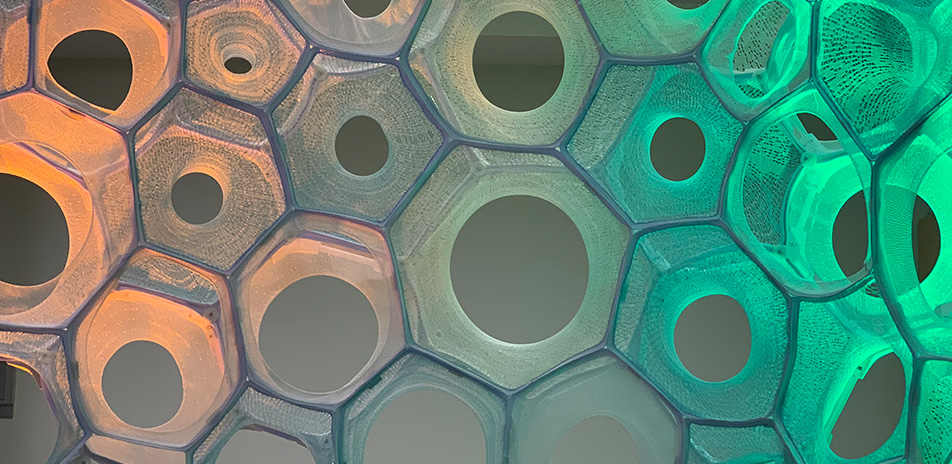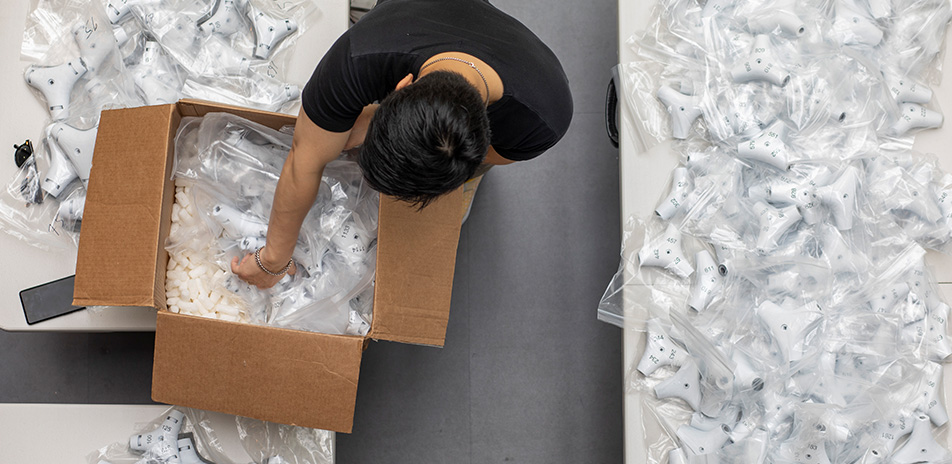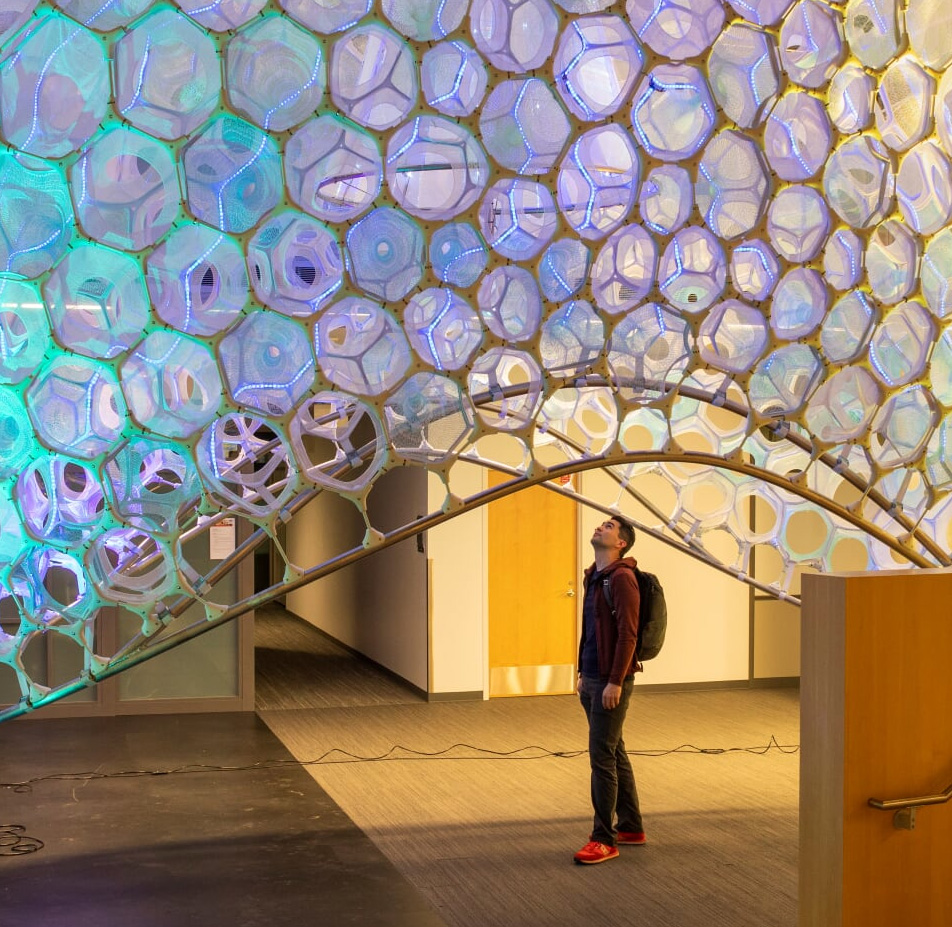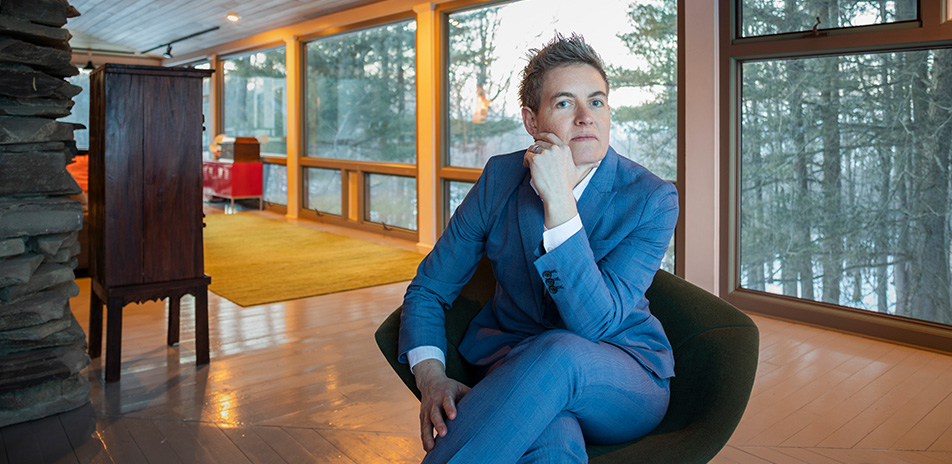
The first architectural pavilion project to incorporate artificial intelligence, Ada’s knitted light immerses visitors in a responsive and interactive glow of photoluminescence driven by individual and collective expression data gathered and housed within Microsoft Research Building 99.
Named after Ada Lovelace—the polymath, mathematician, first computer programmer, and early innovator of the computer age—Ada is a collaboration by architectural designer Jenny Sabin and Microsoft Research, embodying performance, material innovation, human-centered adaptive architecture, and emerging technologies.

Ada builds upon 13 years of collaborative innovation across architecture and science, where projects are informed by and embrace technology, non-standard and bio-steered concepts, and the hidden spatial structures within data.
Importantly, Ada is human-driven—a cyber-physical architecture that is adaptive, personal, data-driven, and informed by individual and collective participation. It is a project that celebrates AI, an architecture that is ‘happy to see you’ and ‘smiles back at you.’

A network of sensors and cameras located throughout the building offer opportunities for Ada’s audience to engage, interact with, and drive the project. The data includes expression count, voice tones, and gestures that are processed by AI algorithms and correlated with sentiment. Three scales of responsive and gradated lighting include a network of addressable LEDs, a custom fiber optic central tensegrity cone, and five external PAR lights responding in real time to continuous streams of data. Specific expression data are correlated with colors, spatial zones within the project, and responsive materials.

A lightweight knitted pavilion structure of responsive and data-driven tubular and cellular components employs textiles and photoluminescent fibers that absorb, collect, and emit light. An external rigid experimental shell structure, assembled from a compressive network of 890 unique 3D-printed nodes and fiberglass rods, holds Ada’s form in continuous tension.
About the artist

Jenny E. Sabin is an architectural designer whose work is at the forefront of a new direction for 21st century architectural practice—one that investigates the intersections of architecture and science, and applies insights and theories from biology and mathematics to the design of material structures.
Sabin is the Arthur L. and Isabel B. Wiesenberger Professor in Architecture and Associate Dean for Design at Cornell College of Architecture, Art, and Planning, where she established a new advanced research degree in Matter Design Computation. She is principal of Jenny Sabin Studio, an experimental architectural design studio based in Ithaca and director of the Sabin Lab at Cornell AAP, a transdisciplinary design research lab with specialization in computational design, data visualization, and digital fabrication. In 2006, she co-founded the Sabin+Jones LabStudio, a hybrid research and design unit, together with biologist Peter Lloyd Jones. Sabin is also a founding member of the Nonlinear Systems Organization (NSO), a research group started by Cecil Balmond at PennDesign, where she was Senior Researcher and Director of Research.
Sabin’s collaborative research, including bioinspired adaptive materials and 3D geometric assemblies, has been funded substantially by the National Science Foundation with applied projects commissioned by diverse clients such as Nike Inc., Microsoft Research, Autodesk, the Cooper Hewitt Smithsonian Design Museum, the American Philosophical Society Museum, the Museum of Craft and Design, the Philadelphia Redevelopment Authority, and the Exploratorium.
Sabin holds degrees in ceramics and interdisciplinary visual art from the University of Washington and a Master of Architecture from the University of Pennsylvania, where she was awarded the AIA Henry Adams first-prize medal and the Arthur Spayd Brooke gold medal for distinguished work in architectural design in 2005. She was awarded a Pew Fellowship in the Arts in 2010 and was named a USA Knight Fellow in Architecture—one of fifty artists and designers awarded nationally by US Artists. In 2014, she was awarded the prestigious Architectural League Prize for Young Architects and was named the 2015 national IVY Innovator in design. Architectural Record’s national Women in Architecture Awards selected her for the 2016 Innovator in design. She has exhibited nationally and internationally, including in the ninth acclaimed ArchiLab, titled Naturalizing Architecture, at FRAC Centre in Orleans, France, and as part of Beauty, the fifth Cooper Hewitt Design Triennial. Recently, her work was on view in the exhibition, Imprimer Le Monde at the Centre Pompidou.
Her work has been published extensively, including in The New York Times, The Architectural Review, Azure, A+U, Metropolis, Mark Magazine, 306090, American Journal of Pathology, Science, and Wired Magazine. She co-authored Meander, Variegating Architecture with Ferda Kolatan in 2010. Her book, LabStudio: Design Research Between Architecture and Biology, co-authored with Peter Lloyd Jones, was published in July 2017. In 2017, Sabin won the internationally acclaimed MoMA and MoMA PS1 Young Architects Program with her submission, Lumen.

